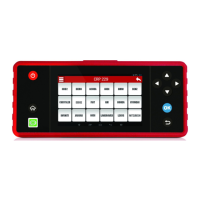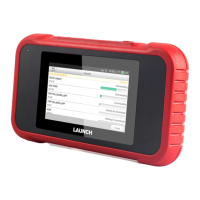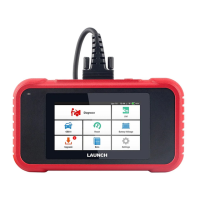LAUNCH
CReader Series English User’s Manual
6
2.6 OBD II Definitions
Powertrain Control Module (PCM) – It is the OBD II terminology for the on-board
computer that controls engine and drive train.
Malfunction Indicator Light (MIL) -- Malfunction Indicator Light (Service Engine
Soon, Check Engine) is a term used for the light on the instrument panel. It is to
alert the driver and/or the repair technician that there is a problem with one or
more of vehicle’s systems and may cause emissions to exceed federal standards.
If the MIL illuminates with a steady light, it indicates that a problem has been
detected and the vehicle should be serviced as soon as possible. Under certain
conditions, the dashboard light will blink or flash. This indicates a severe problem
and flashing is intended to discourage vehicle operation. The vehicle onboard
diagnostic system cannot turn the MIL off until the necessary repairs are
completed or the condition no longer exists.
DTC -- Diagnostic Trouble Codes (DTC) that identifies which section of the
emission control system has malfunctioned.
Enabling Criteria -- Also termed Enabling Conditions. They are the
vehicle-specific events or conditions that must occur within the engine before the
various monitors will set, or run. Some monitors require the vehicle to follow a
prescribed “drive cycle” routine as part of the enabling criteria. Drive cycles vary
among vehicles and for each monitor in any particular vehicle. Please refer to the
vehicle’s factory service manual for specific enabling procedures.
OBD II Drive Cycle -- A specific mode of vehicle operation that provides
conditions required to set all the readiness monitors applicable to the vehicle to
the “ready” condition. The purpose of completing an OBD II drive cycle is to force
the vehicle to run its onboard diagnostics. Some form of a drive cycle needs to be
performed after DTCs have been erased from the PCM’s memory or after the
battery has been disconnected. Running through a vehicle’s complete drive cycle
will “set” the readiness monitors so that future faults can be detected. Drive cycles
vary depending on the vehicle and the monitor that needs to be reset. For vehicle
specific drive cycle, consult the service manual.
Freeze Frame Data -- When an emissions related fault occurs, the OBD II system
not only sets a code but also records a snapshot of the vehicle operating
parameters to help in identifying the problem. This set of values is referred to as
Freeze Frame Data and may include important engine parameters such as engine
